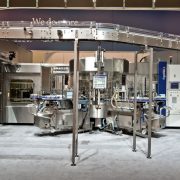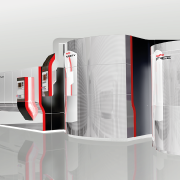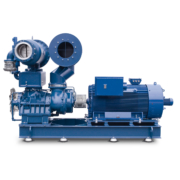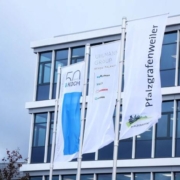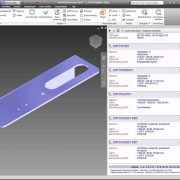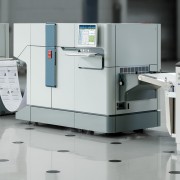Success Story Krones Group: Automatic Data Classification
Higher Quality for Millions of Master Data Records
The Krones Group, global market leader in packaging and bottling technology, uses simus systems GmbH expertise in classifications to improve the quality of their master data. A tailored classification, an automated data classification and a user-oriented search engine support plant manufacturers in reducing the complexity of the parts database and keep the creation of material masters to a minimum. The newly structured range of parts, which was relieved of duplicates, contributes to reducing administration costs company-wide.
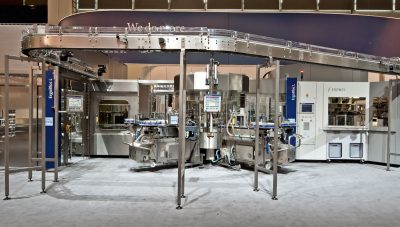
The bottling plant ErgoBloc L stands for preservation of resources, environmental protection and sustainability (Caption: KRONES)
The Krones Group with its headquarter in Neutraubling near Regensburg, Germany, plans, develops and manufactures machines and complete lines for the fields of processing, filling and packaging technology as well as intra logistics. The system manufacturer employs 15,299 members of staff worldwide and caters to a wide range of target industries. Especially for beverage companies, Krones lines have effectively become an industry standard. The worldwide presence of the group is reflected in the amount of master data which has reached the million mark since the foundation of the company in 1951. At the special machine builder Krones, several hundred designers develop highly customized lines which meet the client’s requirements to a tee.
The volume of master data required more extensive search options. The text options of the ERP system were inadequate to cover the complexity sufficiently. Subsequently, the diversity in parts kept growing. Each new master data file causes administration costs. Studies assume that a part causes expenses of approximately 1,000 euro over its life cycle covering design, production, warehouse, purchasing and supply of spare parts. The increase in the diversity of parts is due to the many special parts and new developments at Krones but also standard parts, which have sometimes been created multiple times in the system.
‘Just like any engineer, we have duplicates in our system. There is no way around that. We are now developing strategies to eliminate duplicates or at least stop the growth of the database,’
Thomas Weiss, Project Manager in Krones’ Process Management explains.
Two complementary approaches were identified: On the one hand, a new search tool will supplement previous ERP functions, on the other hand, Krones wants to achieve a higher level of data quality with extensive automated processes. The optimization is supposed to speed up the search for parts. The classification expert simus systems also convinced in the selection process, who could not only provide high-performance search software but also automatic classification of master data and 3D CAD models. Using their expertise in class structures, structuring and processing data, the service provider from Karlsruhe was able to come up with a solution package which best matched the requirements of Krones.
Higher Data Quality Using Automatic Classification
The simus classmate software analyzes the company’s master data with its patented method and captures characteristic features which are used as the basis of class definition tailored to the company. For the automatic conversion to a classification, a set of rules is developed and refined with the help of a graphical editor later on. The software therefore enhances the data with further classification details, standardizes its descriptions and arranges them in appropriate classes. The result is a clearly presented classification structure which already contains automatically rated elements. For the analysis of a 3D CAD model, simus classmate accesses minimal geometrical information afterwards and uses it to determine features and the part’s class.
In the initial stage of the project, Krones stated the requirements for the classification in the shape of class descriptions and handed over 2,000 models as test objects to simus systems. Step by step, the set of rules was refined and adapted until more than 95 per cent of data was correctly classified. Later mass trials including significantly more objects confirmed the notably high value. In order to improve it further, the fine-tuning of the set of rules was continued consistently.
The Krones classification covers 430 classes including 3,500 features. Approximately 2,500 specified rules define classes and features, also taking dependencies into consideration. Before a new object is analyzed by the software, 3,800 text keys are deciding on manual or automatic classification.
Currently, Krones foregoes using the automatic option provided by simus classmate. After completing the development, the designer initiates the classification, computes the classes and features with the software and checks the result manually once more. If sufficient experience has been gained, the last step is supposed to be adopted by the automatic classification in the future.
‘With simus classmate, we can free our designers from tiresome routine tasks. They want to develop and not maintain master data. For now, we are focusing on data quality and keeping the growth rate of parts low – saving time will have to kick in a little later,’
Weiss explains.
Searching for Parts Becomes Easier
Besides the higher quality of the database, the customized classmate FINDER Software facilitates the search for existing parts. At Krones, multiple predefined selection options and pictograms assist the user in entering the right search parameters. In a few seconds, the software presents the search results. Preview images, a catalog of single data items and an interactive 3D view of the part facilitate the identification. For similar parts, datasets can be compared and differences be highlighted in color.
‘The user Interface is structured well. Users learn to navigate quickly,’ Weiss explains. ‘In addition, the program needs little memory which results in minimum waiting time.’
The introduction of the system is met with a positive response by the majority of users. Further training sessions, informative meetings and later e-learning sessions are intended to help reduce any remaining skepticism. Additionally, Krones implemented a news stream to the software. During the start of the program, central memos and messages of system administrators are displayed and information is gradually distributed to all users. A selection of tips and tricks allow a self-learning experience without the need to make any additional inquiries.
Besides several hundred designers, users from other departments, such as Purchasing or Spare Parts, use the software as a reference tool or search engine. The number of users adds up to far more than 1,000 people accessing the system regularly. Based on the feedback, Thomas Weiss can rest assured that the use of the software has the desired effect.
‘Introducing automatic classification was a strategic decision which is going to pay off in the next years. The data quality alone will benefit us in many ways,’
Weiss says. Krones is planning a more extensive evaluation of the use. By comparing new systems from 2008-2010 with those of 2011, it will be determined to what degree the increase in duplicate parts can potentially be reduced.
Krones is currently speeding up the plans to reduce the duplicates in standard and purchased parts with the help of the new classification. Further significant savings are anticipated, as more and more parts drop out of the system at the end of their life cycle.
Image Rights: Krones AG, Neutraubling, Germany

